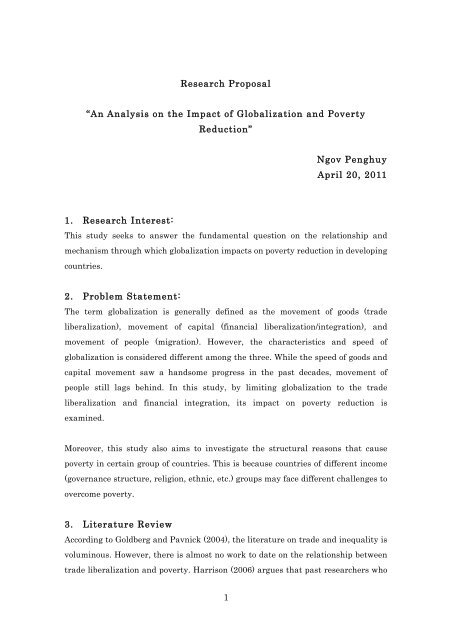An Analysis on the Impact of globalization on Poverty Reduction-1
An Analysis on the Impact of globalization on Poverty Reduction-1
An Analysis on the Impact of globalization on Poverty Reduction-1
Create successful ePaper yourself
Turn your PDF publications into a flip-book with our unique Google optimized e-Paper software.
Research Proposal<br />
“<str<strong>on</strong>g>An</str<strong>on</strong>g> <str<strong>on</strong>g>An</str<strong>on</strong>g>alysis <strong>on</strong> <strong>the</strong> <strong>Impact</strong> <strong>of</strong> Globalizati<strong>on</strong> and <strong>Poverty</strong><br />
Reducti<strong>on</strong>”<br />
Ngov Penghuy<br />
April 20, 2011<br />
1. Research Interest:<br />
This study seeks to answer <strong>the</strong> fundamental questi<strong>on</strong> <strong>on</strong> <strong>the</strong> relati<strong>on</strong>ship and<br />
mechanism through which globalizati<strong>on</strong> impacts <strong>on</strong> poverty reducti<strong>on</strong> in developing<br />
countries.<br />
2. Problem Statement:<br />
The term globalizati<strong>on</strong> is generally defined as <strong>the</strong> movement <strong>of</strong> goods (trade<br />
liberalizati<strong>on</strong>), movement <strong>of</strong> capital (financial liberalizati<strong>on</strong>/integrati<strong>on</strong>), and<br />
movement <strong>of</strong> people (migrati<strong>on</strong>). However, <strong>the</strong> characteristics and speed <strong>of</strong><br />
globalizati<strong>on</strong> is c<strong>on</strong>sidered different am<strong>on</strong>g <strong>the</strong> three. While <strong>the</strong> speed <strong>of</strong> goods and<br />
capital movement saw a handsome progress in <strong>the</strong> past decades, movement <strong>of</strong><br />
people still lags behind. In this study, by limiting globalizati<strong>on</strong> to <strong>the</strong> trade<br />
liberalizati<strong>on</strong> and financial integrati<strong>on</strong>, its impact <strong>on</strong> poverty reducti<strong>on</strong> is<br />
examined.<br />
Moreover, this study also aims to investigate <strong>the</strong> structural reas<strong>on</strong>s that cause<br />
poverty in certain group <strong>of</strong> countries. This is because countries <strong>of</strong> different income<br />
(governance structure, religi<strong>on</strong>, ethnic, etc.) groups may face different challenges to<br />
overcome poverty.<br />
3. Literature Review<br />
According to Goldberg and Pavnick (2004), <strong>the</strong> literature <strong>on</strong> trade and inequality is<br />
voluminous. However, <strong>the</strong>re is almost no work to date <strong>on</strong> <strong>the</strong> relati<strong>on</strong>ship between<br />
trade liberalizati<strong>on</strong> and poverty. Harris<strong>on</strong> (2006) argues that past researchers who<br />
1
advocate global ec<strong>on</strong>omic integrati<strong>on</strong> should help <strong>the</strong> poor since poor countries have<br />
a comparative advantage in producing goods that use unskilled labor, is misleading.<br />
She c<strong>on</strong>tinues to emphasize that <strong>the</strong> poor are more likely to share <strong>the</strong> gains from<br />
globalizati<strong>on</strong> when <strong>the</strong>re are complementary policies in place, such as investments<br />
in human capital, infrastructure, credit and technical assistance to farmers, and<br />
macroec<strong>on</strong>omic stabilizati<strong>on</strong> policies. At <strong>the</strong> same time, <strong>the</strong> winners and losers<br />
am<strong>on</strong>g <strong>the</strong> poor in developing countries also emerge depending <strong>on</strong> <strong>the</strong> sectors in<br />
which <strong>the</strong>y are engaged. The winners are likely to be those, as a result <strong>of</strong> trade and<br />
foreign investment reforms, in exporting sectors and sectors that receive FDI<br />
(foreign direct investment). On <strong>the</strong> c<strong>on</strong>trary, for those in import-competing sectors<br />
are likely to be hurt by <strong>the</strong> globalizati<strong>on</strong>.<br />
4. Research Methodology<br />
There are several ways <strong>of</strong> measuring globalizati<strong>on</strong> and poverty. Different<br />
measurement leads to different outcome. If globalizati<strong>on</strong> is measured by <strong>the</strong> degree<br />
<strong>of</strong> <strong>the</strong> openness <strong>of</strong> trade, <strong>the</strong>n trade volumes and measures <strong>of</strong> trade policy are<br />
comm<strong>on</strong>. According to Harris<strong>on</strong> (2006), most researchers prefer <strong>the</strong> use <strong>of</strong> direct<br />
trade policy measures such as tariffs or quota vis-à-vis to trade volumes, typically<br />
measured as shares to GDP. Trade shares are not ideal because <strong>the</strong>y are<br />
determined by trade policies, geography, country size, and macro ec<strong>on</strong>omic policies.<br />
The c<strong>on</strong>cept <strong>of</strong> poverty is also diverse. One <strong>of</strong> <strong>the</strong> comm<strong>on</strong>ly used indicators for<br />
internati<strong>on</strong>al comparis<strong>on</strong> is poverty incident by <strong>the</strong> United Nati<strong>on</strong>s (UN), defined as<br />
<strong>the</strong> share <strong>of</strong> people who lives below <strong>the</strong> poverty line, 1 USD per day. In 2008, this<br />
poverty line was revised by <strong>the</strong> World Bank to 1.25 USD at 2005 purchasing-power<br />
parity. <strong>Poverty</strong> measured by this poverty gap is called ec<strong>on</strong>omic poverty. Although<br />
ec<strong>on</strong>omic poverty is <strong>the</strong> most frequently used, it is also c<strong>on</strong>sidered as <strong>the</strong> end result<br />
<strong>of</strong> poverty, which is actually affected by o<strong>the</strong>r factors including social and political<br />
<strong>on</strong>es. In this study, <strong>the</strong> author broadens <strong>the</strong> c<strong>on</strong>cept <strong>of</strong> poverty to three aspects: 1)<br />
Ec<strong>on</strong>omic <strong>Poverty</strong>, 2) Social <strong>Poverty</strong>, and 3) Political <strong>Poverty</strong>. Ec<strong>on</strong>omic poverty<br />
refers to those who make <strong>the</strong>ir living below <strong>the</strong> poverty line. Social poverty refers to<br />
those who are situated below a certain level <strong>of</strong> formal educati<strong>on</strong>, social exclusi<strong>on</strong><br />
group, and life expectancy. Political poverty refers to <strong>the</strong> group <strong>of</strong> people that lacks<br />
2
(or is sufficient <strong>of</strong>) freedom <strong>of</strong> speech, freedom <strong>of</strong> media, and freedom to elect <strong>the</strong>ir<br />
leader in a free and fair electoral process.<br />
After having properly set <strong>the</strong> definiti<strong>on</strong> <strong>of</strong> globalizati<strong>on</strong> and poverty, cross-country<br />
analysis, panel analysis, and dynamic panel analysis will be carried out to<br />
investigate <strong>the</strong> impacts <strong>of</strong> globalizati<strong>on</strong> <strong>on</strong> poverty. However, <strong>the</strong> relati<strong>on</strong>ship<br />
between globalizati<strong>on</strong> and poverty reducti<strong>on</strong> may not be direct. This can be<br />
indirectly affected through <strong>the</strong> growth-effect and distributi<strong>on</strong>al effect channels.<br />
The data set to be used in <strong>the</strong> analysis must cover a wide range <strong>of</strong> countries and be<br />
suitable for cross-country comparis<strong>on</strong>. Potential sources <strong>of</strong> data include WDI (World<br />
Development Indicator), HDI (Human Development Indicator), FH (Freedom<br />
House), MDG (Millennium Development Goal), etc.<br />
References:<br />
Goldberg, Penny and Nina Pavnick (2004), ”Trade, Inequality, and <strong>Poverty</strong>: What<br />
Do We Know? Evidence from Recent Trade Liberalizati<strong>on</strong> Episodes in Developing<br />
Countries”, NBER Working Paper No. 10593.<br />
Harris<strong>on</strong>, <str<strong>on</strong>g>An</str<strong>on</strong>g>n (2006), “Globalizati<strong>on</strong> and <strong>Poverty</strong>”, NBER Working Paper No.<br />
12347.<br />
3
















